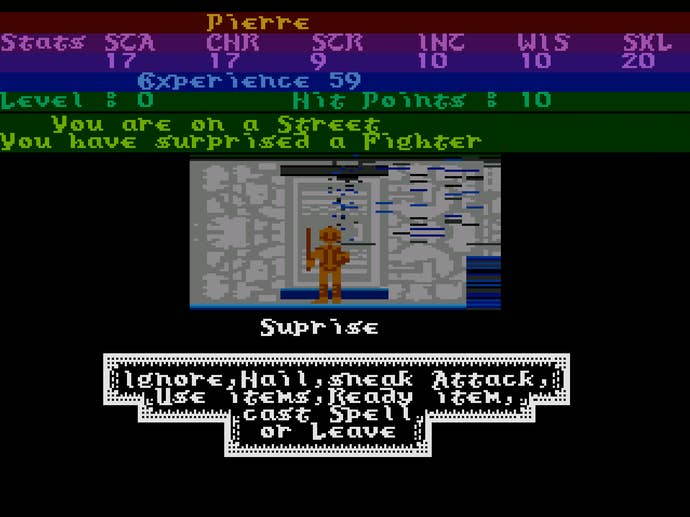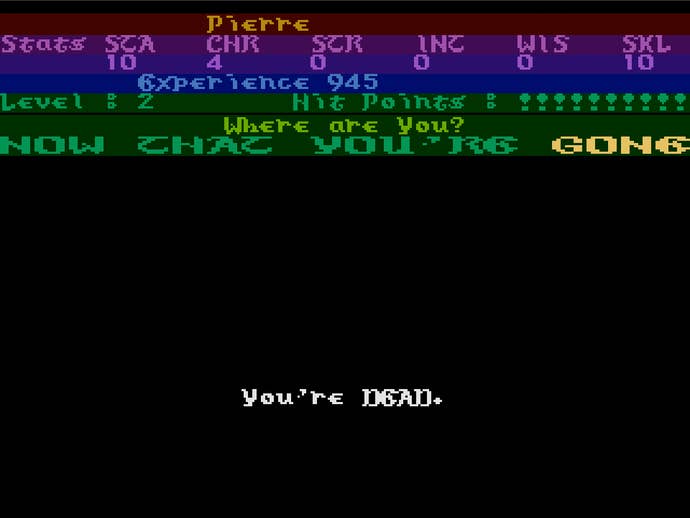Origins of the Open World: Alternate Reality
The coming year looks set to be "the year of open-world" -- but the concept is quite a bit older than you might think.
This article first appeared on USgamer, a partner publication of VG247. Some content, such as this article, has been migrated to VG247 for posterity after USgamer's closure - but it has not been edited or further vetted by the VG247 team.
Open-world games may be hot stuff right now -- particularly with the coming new generation of consoles -- but what you might not know is that the idea of offering the player a huge amount of freedom within a non-linear world is a concept that's been around since the early days of gaming.
My earliest encounter with an open-world game came way back in 1985, with the release of a game called Alternate Reality: The City on the Atari 8-bit range of computers. At the time, I was much too young to really understand what was going on, but even at that early age, I appreciated that this game was doing something noticeably different from the norm. It wasn't guiding me down a specific, linear path from level to level; it was allowing me to freely explore and seek out danger as I -- not the game -- wanted.
Alternate Reality: The City was the first in a planned series of first-person perspective role-playing games developed by a man named Philip Price. It was a revolutionary title for a number of reasons -- it was the first 3D role-playing game to feature texture-mapping; it featured day-night cycles and weather systems; and it was one of the most ambitious, sprawling games ever planned. It would be ambitious if it were pitched today, let alone back in 1985 on computers with 48k of RAM; needless to say, it was well ahead of its time, which might account for the complete project's eventual failure.

The overall concept for the series saw the player -- playing themselves rather than a predefined character -- abducted by aliens and taken to another planet, where they found themselves in front of a gate with whirling slot machine-style reels with numbers on all around. Passing through the gate froze the numbers in place and turned the player into a new person, setting their base statistics in place. From that point on, they're thrown into the mysterious medieval-style city of "Xebec's Demise" and tasked with finding a way home.
The exact way you're supposed to go about finding a way home is never made explicit, and in fact the game as it exists is not possible to "beat." Rather, the challenge in The City comes from the art of survival; brought all but penniless into a strange other world, you'll have to work hard just to find safe lodgings for the night, because there are plenty of people roaming the streets who would like nothing more than to see you dead.
The City subverted a number of expectations that people already had for the fledgling computer-based role-playing game genre. The lack of achievable end goal was one, but so too was the amount of freedom afforded the player. The game systems that ran behind the scenes -- mostly invisibly to the player -- tracked all manner of different things, in a much greater level of depth than even the most ambitious games we get today. We're talking about a game that simulates your digestive system and determines exactly how long various types of poison will take to course through your body before killing you, for example; a game where you can smell and taste potions before drinking them to try and figure out what they are; a game where your stats aren't fixed, but instead will increase and decrease according to your actions in the world.

It was an enormously immersive world, too; wander around and you'd hear things going on in the buildings around you; stay outside long enough and you'd be able to watch the sun set. Pop in to a local tavern at the right time and there'd be a chance you'd witness someone singing a song, with the lyrics flowing by in karaoke style across the top of the screen. Over time, you'd be able to navigate your way around through memory and not having to rely on a map -- which, naturally, you'd have to draw yourself, because this was 1985 and automap facilities didn't exist.
One of the most interesting aspects of the game at the time was that not everyone or thing you came across in the streets via random encounter was unfriendly. The natural reaction for an RPG player at the time was to attack anything that showed up unexpectedly, but this was a sure-fire route to a quick death in The City. Attacking civilians and town guards would lower one of your "hidden" statistics that tracked your reputation, causing you to be attacked on sight by formerly friendly characters after a while. The key thing, though, was that you had the freedom to be "evil" if you wanted to; if you could build up your strength and equipment enough to a point where you were hard to defeat, sure, you could absolutely go on a killing spree.
That much freedom can bring a sense of bewilderment, though. With no clearly-defined end goal, it was easy to wander aimlessly in The City and find yourself starving to death, your stats dropping with every step you take; it was just as easy to accidentally do something that caused your reputation to drop like a rock, making you unwelcome in any of The City's safe havens and thus doomed to a life on the street.

This was a brutal, unforgiving sort of game, and it wanted you to suffer. It wasn't the sort of sterile, consequence-free "sandbox" we have in open-world games today; this was a hostile environment that was outright trying to kill you -- one that would punish you for making mistakes. Much of the satisfaction from playing The City came from beating that environment at its own game and surviving for longer than your previous attempt. In some senses, there was an element of the roguelike genre about it, albeit without the randomly-generated levels. It was a game made to be replayed, with each new incarnation of your avatar able to apply the knowledge you'd learned on your last run and hopefully survive a little longer.
The sense of aimlessness in The City was intended to be resolved over the course of seven games in total. The player would begin in The City, which acted as a "hub world" for the other six titles, which were The Dungeon (originally intended to be The City's sewers), The Arena, The Palace, The Wilderness, Revelations and Destiny. Each would feature its own unique gameplay mechanics -- the Arena would send you into gladiatorial combat, for example, including against other characters on your save game disk; The Palace, meanwhile, would allow you to become a ruler of the city and make changes to its layout.
Revelations and Destiny, on the other hand, were intended to bring things to a climax and wrap up the story as a whole; the "revelation" was supposed to be that the player would discover the bodies of thousands of other people cocooned and frozen, all sharing the same delusion that they were inhabiting the city of Xebec's Demise. Ultimately, the player would be given a number of options: destroy the world of Alternate Reality; escape and go back to Earth; bring it back for scientists to study it; or even sell out humanity altogether.
Sadly, of the six sequels to The City, only The Dungeon was ever completed and released, meaning the saga of Alternate Reality would be forever left unfinished. The Dungeon provided a more directed quest with a more obvious end goal, but the fact that there was no way for the player character to ever make it home gave the whole experience something of an air of tragedy; however well you do in both games, the only possible ending is for you to die.

A bit like life, really. There's a cheery thought for you this Thursday afternoon. Have a pleasant day.








